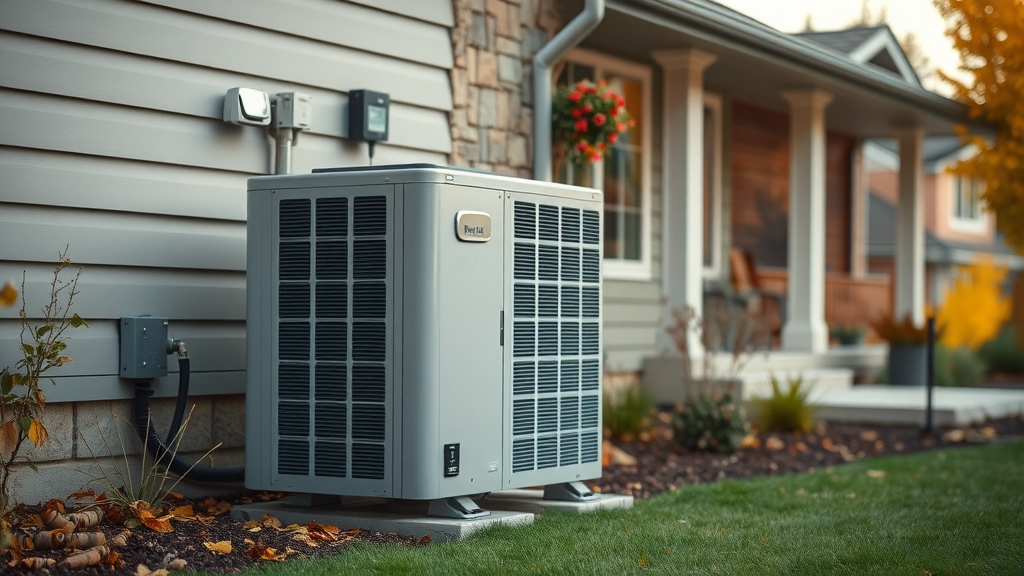"Did you know that over 40% of home energy bills are spent on heating alone? Discover effective ways to heat your home while keeping expenses in check."
- In this comprehensive guide, you'll explore proven cost effective heating strategies that leverage the latest heating systems, technologies, and behavioral changes to maximize heating efficiency and minimize energy costs.
What You’ll Learn
- How to select and combine the best cost effective heating strategies for modern homes
- Ways to balance home comfort, energy efficiency, and heating costs
- Real-life examples to make your home heating more efficient and affordable
- Step-by-step guidance on smart upgrades, insulation, and maintenance
- How to compare heating system types and operating costs
- Expert tips for maximizing savings on your energy bill

Understanding Cost Effective Heating Strategies for Every Home
Navigating the world of cost effective heating strategies means making informed choices that directly reduce your energy bills while maintaining the comfort of your home. What defines a truly effective heating approach in today’s homes is a smart blend of efficient equipment, the right heating system for your needs, and adopting energy-conscious behaviors. Modern heating systems and technology offer homeowners options that weren’t available even a decade ago, making it easier than ever to balance warmth with energy cost savings.
Balancing comfort, efficiency, and energy costs calls for evaluating both your habits and your heating equipment. For example, regularly servicing your heating system , sealing drafts, and maintaining insulation will sustain efficient heat throughout the coldest months. Choosing the right heating systems is equally vital; heat pumps, gas furnaces, and radiant floors each have unique energy cost profiles and performance ratings. Consider your property’s layout, your comfort preferences, and your budget when making upgrades—these decisions are crucial in determining how efficiently and affordably you can heat your home.
Ultimately, the type of heating system you select can dramatically influence annual energy costs and the size of your energy bill. Below is a comparative table of popular heating systems that highlights their yearly costs, upfront investment, and efficiency rates, setting the stage for making smarter, more cost-efficient choices when you invest in home heating solutions.
| Heating System | Average Cost per Year | Initial Investment | Efficiency Rate (%) |
|---|---|---|---|
| Gas Furnace | $600 | $$$ | 78-98 |
| Heat Pump | $500 | $$$$ | 200-300 |
| Electric Baseboard | $900 | $$ | 95 |
| Radiant Floor | $700 | $$$$ | 85 |

The Role of Modern Heating Systems in Cost Effective Heating Strategies
Comparing Traditional and Modern Heating Systems for Effective Heating
Choosing between a central heating system and a ductless mini-split can have a significant impact on your comfort and energy bill. Central systems, whether using natural gas or electricity, distribute heat through ducts, which can be less efficient if not well-maintained. Ductless mini-splits, on the other hand, provide precise, zoned heating, allowing you to heat only occupied spaces, which increases your home's overall heating efficiency and can reduce your energy costs by avoiding energy loss in unused areas.
Evaluating the various options—such as gas furnaces , radiant heat, and electric systems—uncovers a spectrum of pros and cons for each. Natural gas systems tend to offer low ongoing energy costs and reliable heating, but their installation and maintenance may be higher, especially in older homes. Electric baseboards are easy to install but often cost more to operate due to higher electricity rates. Radiant floor heat offers luxurious comfort and even warmth, though it demands a higher upfront investment.
Technology is transforming home heating efficiency. Smart thermostats, advanced heat distribution systems, and new integration with energy star appliances help your heating system run only when needed, minimizing energy waste . Adopting modern heating systems like heat pumps and high-efficiency furnaces ensures that you get the most efficient heat possible, reducing your carbon footprint and decreasing your annual heating bills.
Harnessing the Power of Heat Pumps for Efficient Heating
Heat pumps are at the forefront of cost effective heating strategies , offering unmatched efficiency by transferring heat from the outside air (even in winter) into your home. Unlike systems that generate heat, heat pumps use electricity more efficiently, often delivering two to three times more heat energy than the electrical energy they consume, making a heat pump an ideal heating solution for many climates.
When shopping for a heat pump, look for energy star rated models to ensure both superior efficiency and lower long-term energy costs . Choosing the right size for your home and climate is critical; consulting with a certified HVAC professional guarantees the system is tailored for optimal performance. Regular heat pump maintenance—like cleaning filters and checking refrigerant levels—not only maximizes comfort but also extends the lifespan of your system, sustaining your energy savings year after year.
Integrating a heat pump into your heating setup is a practical step for many homeowners interested in efficient heat. As an added bonus, many modern heat pumps double as air conditioners, providing year-round climate control and additional savings by consolidating your heating and cooling needs into a single, efficient appliance.

Smart Upgrades: Enhancing Home Heating Efficiency with Technology
Improving Heating System Performance with Smart Thermostats
The introduction of the smart thermostat has revolutionized home heating efficiency and energy savings. By allowing precise control over temperature settings and flexible scheduling, smart thermostats ensure your heating system runs only when needed. Many homeowners notice immediate reductions in heating costs, as a smart thermostat can automatically adjust heat output based on occupancy, weather patterns, and personal routines—lowering your energy bill without sacrificing comfort.
Setting an optimal temperature schedule is crucial for energy saving . Program your smart thermostat to reduce the temperature during the night or when the house is empty, and to warm rooms just before you wake up or return home. Most smart thermostats offer compatibility with a wide range of HVAC system models, making it easy to retrofit existing systems for greater efficiency.
Upgrading to a smart thermostat isn’t just about convenience—it’s a powerful tool for maximizing your heating efficiency and gaining real-time insights into your energy usage. Many systems provide user-friendly apps and energy reports, allowing you to track savings, make adjustments, and further fine-tune your home’s energy footprint for year-round cost savings.
Sealing, Insulation, and HVAC System Upgrades for Cost Effective Heating Strategies
Eliminating wasted energy starts with proper home insulation and sealing drafty gaps. Gaps around windows, doors, and even attic hatches can let precious heat escape, making your heating system work harder and driving up your energy bills. Upgrading your insulation—especially in the attic and basement—keeps heat inside, ensuring your investment in efficient heating delivers maximum comfort and energy efficiency.
Consider upgrading to a high-efficiency heating system, such as a modern heat pump or high-efficiency gas furnace , to further drive down your heating costs. Today’s energy star models are designed for maximum performance, offering significantly lower operational expenses than older heating equipment. Routine maintenance—such as cleaning filters, checking ductwork, and scheduling professional checkups—ensures your HVAC system operates at full capacity, preventing breakdowns and maintaining consistent heating efficiency.
Insulating and sealing your home, paired with advanced heating systems and regular care, is one of the most effective ways to heat your home affordably. Investing in these upgrades might seem daunting, but the return in energy savings and comfort quickly pays off—often in just a few heating seasons—putting you in control of your household energy costs.

Effective Ways to Heat Your Home on a Budget
Tackling high heating bills doesn’t always require a major overhaul of your system. Sometimes, the most effective ways to heat your home and cut energy costs involve simple behavioral changes and targeted upgrades. Layering clothing allows you to comfortably lower thermostat settings, helping you save significantly without sacrificing warmth.
Implementing programmable timers or smart scheduling helps ensure your heating system isn't running when it’s not needed. Zone heating and closing off unused rooms focus the available heat where it matters most, reducing demand and ensuring efficient heat delivery. Using energy-efficient space heaters can be practical for spot heating rooms you use most, and leveraging passive solar heating—like letting sunlight warm your home through large windows during the day—provides free, renewable warmth.
- Layer clothing and use programmable timers
- Zone heating and closing off unused rooms
- Use energy-efficient space heaters when appropriate
- Take advantage of passive solar heating during the day

"Switching to an efficient heating system can recoup initial costs in as little as two years, dramatically reducing household energy bills."
Comparing Energy Costs: Heating Methods Breakdown
Understanding the comparative costs for different heating methods is crucial when planning for a more energy-efficient home. Below is a simple breakdown of the most common home heating systems, showing their upfront and ongoing costs, and their suitability for various home types. This side-by-side comparison empowers you to select a cost effective heating strategy that meets your comfort needs without straining your budget.
| Method | Upfront Cost | Operating Cost | Best For |
|---|---|---|---|
| Natural Gas Furnace | Medium | Low | Large homes |
| Heat Pump | High | Very Low | All climates |
| Radiant Floor | High | Medium | New builds/renov. |
| Space Heater | Low | High | Spot heating/rooms |
While space heaters may seem inexpensive at first, they are best reserved for occasional spot heating due to their high operating costs. For whole-home, long-term savings, energy-efficient heat pumps and natural gas furnaces offer the best combination of low heating costs and reliable comfort. If you’re planning major renovations or building a new home, radiant floor heating can provide consistent warmth and efficiency, though it comes with a higher upfront investment.
Expert Recommendations: Combining Heating and Cooling for Ultimate Savings
- Benefits of dual-purpose heat pumps for heating and cooling
- Synchronizing seasonal maintenance for efficiency
- How to offset energy bills with renewable options
Combining heating and cooling within a single system can maximize energy savings all year. Dual-purpose heat pumps provide both efficient heating in winter and cooling in summer. This approach eliminates the need for separate systems, reducing installation and maintenance costs and streamlining your home’s climate control.
Routine seasonal maintenance for both heating and cooling functions—checking refrigerant, replacing filters, and inspecting connections—keeps your system running at peak efficiency. Pairing a heat pump with renewable energy sources, such as rooftop solar panels, can further shrink your energy bills and carbon footprint , making your home more sustainable and cost-effective to operate.

How to Assess Your Home Heating Efficiency and Take Action
- Simple ways to audit home heating efficiency
- Tools and apps to monitor energy consumption
- Checklist for optimizing heating system performance
Getting a clear picture of your home’s heating efficiency starts with a basic audit: check window and door seals, inspect attic and wall insulation, and time how long your heating system needs to maintain comfortable temperatures. Use smartphone apps or smart meters to track your daily and monthly energy usage ; these can highlight spikes in consumption and flag areas for improvement.
Reviewing the operation of your HVAC system includes examining thermostat settings, filter cleanliness, and ductwork integrity. Make a checklist of routine maintenance items, such as replacing filters every few months, scheduling an annual professional inspection, and checking vents and radiators for blockages. Simple, regular attention helps prevent your system from wasting energy and running longer than necessary.
For a thorough assessment, consider engaging an HVAC expert for a professional energy audit. They can use thermal imaging and airflow tests to identify hidden inefficiencies, providing specific recommendations to boost your heating system performance and cut energy costs for years to come.
People Also Ask
What is the most cost-effective heating method?
- Heat pumps are widely regarded as the most cost-effective heating method due to their high efficiency and low operating cost, particularly when combined with adequate insulation and smart thermostat controls.
What is the cheapest way to run heating?
- The cheapest way to run heating is to combine a programmable thermostat with energy-efficient appliances, maintain your HVAC system, and incorporate recommended behavioral changes like zoning and layered clothing.
What is the cheapest thing to heat your house with?
- Space heaters can be cost-efficient for individual rooms, but for whole-home heating, heat pump systems or natural gas furnaces yield the lowest costs over time.
What is the most cost effective way to keep house warm?
- The most cost effective way to keep your house warm is to combine insulation, a modern heating system (such as a heat pump), a smart thermostat, and simple behavioral modifications.
Frequently Asked Questions on Cost Effective Heating Strategies
- How often should I service my heating system for maximum efficiency? You should have your heating system serviced by a professional at least once a year, ideally before the heating season begins. Regular maintenance ensures optimal performance, improves safety, and helps identify minor issues before they become costly repairs.
- Is it worth investing in a new efficient heating system if mine is less than 10 years old? If your current system is in good working order and energy efficient, upgrading may not be urgent. However, if you notice rising energy bills, uneven heating, or frequent repairs, investing in a newer, more efficient system can pay off quickly in lower operating costs and improved comfort.
- Can smart thermostats adapt to my schedule automatically? Yes, most modern smart thermostats feature learning algorithms that track your usage patterns and adjust heating schedules accordingly. Some models also use geofencing or sensors to detect occupancy, further boosting heating efficiency.
- Are heat pumps efficient in extremely cold climates? Yes, advancements in heat pump technology, including cold-climate models, mean that today’s heat pumps can efficiently heat homes even when outdoor temperatures drop well below freezing. Consult a professional to select the right model for your region.
Summary of Key Cost Effective Heating Strategies and Action Steps
- Evaluate and upgrade your home insulation
- Install programmable or smart thermostats
- Choose and maintain modern heating systems (heat pumps, high-efficiency furnaces)
- Leverage passive solar and zoned heating
- Regularly service all home heating systems for optimal performance
"Empowering yourself with cost effective heating strategies not only reduces your energy bills but also contributes to a sustainable, comfortable home environment."
Ready to Reduce Your Energy Bill? Explore More Cost Effective Heating Strategies Today
- Contact a certified HVAC professional for a home heating assessment
- Subscribe for more tips on effective ways to heat your home efficiently
- Download our guide to optimizing heating systems for every budget
Take the next step: Start with simple upgrades this season to lower your heating bills and create a warmer, more efficient home all year long.
Sources
- U.S. Department of Energy – https://www.energy.gov/energysaver/home-heating-systems
- ENERGY STAR – https://www.energystar.gov/products/heating_cooling
- National Renewable Energy Laboratory – https://www.nrel.gov/docs/fy14osti/60650.pdf
- Consumer Reports – https://www.consumerreports.org/home-heating-cooling/best-ways-to-heat-your-home
- EPA Renewable Heating & Cooling – https://www.epa.gov/rhc
To further enhance your understanding of cost-effective heating strategies, consider exploring the following resources:
-
“7 Ways To Lower Heating Costs” : This article provides practical tips, including sealing leaks, upgrading thermostats, and maintaining heating systems, to help reduce your heating expenses. ( trane.com )
-
“13 Ways to Keep Your House Warm This Winter” : This guide offers a comprehensive list of methods to improve home insulation, optimize thermostat settings, and utilize natural heat sources effectively. ( thisoldhouse.com )
By implementing the strategies outlined in these resources, you can achieve significant energy savings and maintain a comfortable home environment throughout the colder months.
 Add Row
Add Row  Add
Add 




Write A Comment